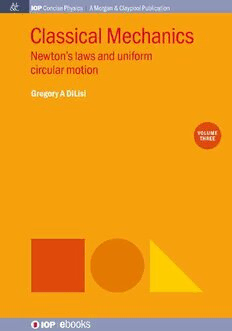
Classical Mechanics, Volume 3: Newton's Laws and Uniform Circular Motion PDF
Preview Classical Mechanics, Volume 3: Newton's Laws and Uniform Circular Motion
Classical Mechanics, Volume 3 Newton’s laws and uniform circular motion Classical Mechanics, Volume 3 Newton’s laws and uniform circular motion Gregory A DiLisi John Carroll University, University Heights, Ohio, USA Morgan & Claypool Publishers Copyrightª2019Morgan&ClaypoolPublishers Allrightsreserved.Nopartofthispublicationmaybereproduced,storedinaretrievalsystem ortransmittedinanyformorbyanymeans,electronic,mechanical,photocopying,recording orotherwise,withoutthepriorpermissionofthepublisher,orasexpresslypermittedbylawor undertermsagreedwiththeappropriaterightsorganization.Multiplecopyingispermittedin accordancewiththetermsoflicencesissuedbytheCopyrightLicensingAgency,theCopyright ClearanceCentreandotherreproductionrightsorganizations. CertainimagesinthispublicationhavebeenobtainedbytheauthorfromtheWikipedia/ Wikimediawebsite,wheretheyweremadeavailableunderaCreativeCommonslicenceorstated tobeinthepublicdomain.Pleaseseeindividualfigurecaptionsinthispublicationfordetails.To theextentthatthelawallows,IOPPublishingandMorgan&ClaypoolPublishersdisclaimany liabilitythatanypersonmaysufferasaresultofaccessing,usingorforwardingtheimages.Any reuserightsshouldbecheckedandpermissionshouldbesoughtifnecessaryfromWikipedia/ Wikimediaand/orthecopyrightowner(asappropriate)beforeusingorforwardingtheimages. Rights&Permissions Toobtainpermissiontore-usecopyrightedmaterialfromMorgan&ClaypoolPublishers,please [email protected]. ISBN 978-1-64327-314-3(ebook) ISBN 978-1-64327-311-2(print) ISBN 978-1-64327-312-9(mobi) DOI 10.1088/2053-2571/ab1894 Version:20190701 IOPConcisePhysics ISSN2053-2571(online) ISSN2054-7307(print) AMorgan&ClaypoolpublicationaspartofIOPConcisePhysics PublishedbyMorgan&ClaypoolPublishers,1210FifthAvenue,Suite250,SanRafael,CA, 94901,USA IOPPublishing,TempleCircus,TempleWay,BristolBS16HG,UK This book is dedicated to my family: to my grandparents, Tommaso and Carmela Frate, to my parents, Richard and Mary DiLisi, to my siblings, Rick DiLisi, Carla Solomon, and Jennifer Newton, to my wife, Linda, to my daughter, Carmela, and to the wonderful creatures who inhabit our home. Contents Preface ix Author biography xiv Part I Newton’s laws of motion 1 Motivation 1-1 2 Getting ready 2-1 2.1 Anticipatory set 2-1 2.1.1 Who should (or should not) use the product 2-2 2.1.2 How should the product be used 2-2 2.1.3 What problems should users expect to encounter 2-2 2.2 Objective 2-3 2.3 Purpose 2-3 3 Giving information 3-1 3.1 Instructional input 3-1 3.1.1 Newton’s first law of motion 3-3 3.1.2 Newton’s second law of motion 3-11 3.1.3 Newton’s third law of motion 3-15 3.1.4 Problem-solving 3-20 3.1.5 Category #1: applied forces 3-20 3.1.6 Category #2: contact forces 3-28 3.1.7 Category #3: field forces 3-31 3.2 Modeling 3-38 3.3 Checking for understanding 3-51 4 Keeping information 4-1 4.1 Closure 4-1 4.2 Independent practice 4-3 4.2.1 Challenge problems 4-6 4.3 Peer teaching 4-8 4.3.1 General laws 4-8 4.3.2 Forces: Tension 4-9 vii ClassicalMechanics,Volume3 4.3.3 Forces: Spring Force 4-9 4.3.4 Forces: Frictional Force 4-9 4.3.5 Axes 4-9 4.3.6 Solving 4-10 Part II Uniform circular motion 5 Motivation 5-1 6 Getting ready 6-1 6.1 Anticipatory set 6-1 6.2 Objective 6-4 6.3 Purpose 6-4 7 Giving information 7-1 7.1 Instructional input 7-1 7.1.1 What is ‘uniform’ about ‘uniform circular motion’? 7-1 7.1.2 Acceleration during uniform circular motion 7-6 7.1.3 Putting it all together 7-12 7.2 Modeling 7-13 7.3 Checking for understanding 7-17 8 Keeping information 8-1 8.1 Closure 8-1 8.2 Independent practice 8-2 8.3 Peer teaching 8-3 8.3.1 Centripetal acceleration 8-4 8.3.2 Newton’s laws of motion 8-4 viii Preface We derive the word ‘physics’ from the Greek word ‘physika,’ which translates into ‘pertainingtonaturalthings.’Therefore,aswebeginourstudyof‘physics,’wequite literally begin our study of ‘natural things.’ When I was in high school, my physics teacher, Mr Lamovsky, once asked me: ‘Who is the greatest physicist? Newton? Einstein?Galileo?’Ithoughtforamomentandgavehimananswerthatabsolutely flooredhim.‘Batman,’Isaid,‘becausehisentirelifeisdedicatedtofiguring-outhow and why things move … grapplings, cables, levers, cars, projectiles, etc.’ In short, that’s what this book is about—figuring out how and why things move. Instead of viewing physics as the study of ‘natural things’ (from its literal Greek translation), a good way to view physics is to simply think of it as the study of motion. In fact, Albert Einstein once said: ‘Nothing happens until something moves.’ Think about it … you cannot generate a thought without some electrical signalmovinginyourbrain.Evenyouremotionsinvolvethecomplexmovementof chemical and electrical signals throughout your body. I think we can all agree with Einstein that indeed nothing happens until something moves! Pay careful attention and you will notice that every problem you will encounter in this book involves somethingmoving.Therefore,thegoalofanygoodphysicsbookisquitesimple:to develop problem-solving techniques that handle different types of motion. The situations we encounter in everyday life vary considerably and so our problem- solvingtechniques mustvaryaccordingly.Wewill discoverthatthe techniquesthat defeat the Joker may not work well on the Riddler or Penguin. Therefore, we will developanentirearsenalofproblem-solvingtactics—allofwhicharemeanttohelp us understand the behavior or movement of objects in motion! Before developing these problem-solving techniques, I will describe how I designed thisseriesofbooksandhowtheycametobecreated.First,Iwilldescribe the structure and topics covered in a typical introductory physics sequence of courses. This overarching structure will provide the context for which these texts were designed. Next, I will describe the format of how each topic is presented. The formatwilldemonstratehoweachsectioniswrittenandhoweachtopicinthetextis arranged.Finally,Iwillmorethoroughlydescribetheoverallpurposeoftheseriesof books. 1. Structure of the typical introductory physics sequence of classes: The intro- ductory physics sequence of classes is typically divided into three distinct courses. This series of books focuses on only the first course, ‘Classical Mechanics.’ However, the distinctions among these three courses are useful to see because they frame the context under which ‘Classical Mechanics’ is housed. The distinctions among these three courses are briefly described below: 1. ‘Classical Mechanics’—The term ‘Classical Mechanics’ describes the motion or behavior of objects whose dimensions and/or speeds are familiar to all of us. The objects we examine must have mass. Your intuition from everyday experiences will be generally correct because, ix
